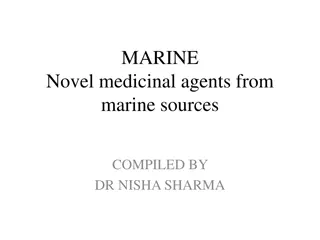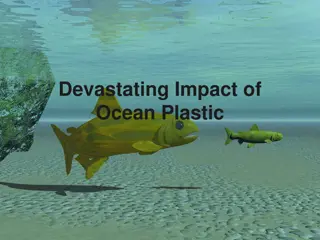Impacts of Climate Change on Oceans and Marine Resources in the United States
The Fourth National Climate Assessment highlights the disruption of ocean ecosystems due to increasing global temperatures, leading to loss of habitats, changes in species composition, and food web structure. Marine fisheries face high risks from climate-driven changes, impacting distribution, timing, and productivity of fishery-related species. Extreme events pose significant threats to marine ecosystems and coastal communities. Climate change is altering marine ecosystems in the U.S., affecting the services they provide, including food from fishing.
Download Presentation

Please find below an Image/Link to download the presentation.
The content on the website is provided AS IS for your information and personal use only. It may not be sold, licensed, or shared on other websites without obtaining consent from the author.If you encounter any issues during the download, it is possible that the publisher has removed the file from their server.
You are allowed to download the files provided on this website for personal or commercial use, subject to the condition that they are used lawfully. All files are the property of their respective owners.
The content on the website is provided AS IS for your information and personal use only. It may not be sold, licensed, or shared on other websites without obtaining consent from the author.
E N D
Presentation Transcript
Fourth National Climate Assessment, Vol II Impacts, Risks, and Adaptation in the United States Chapter 9 | Oceans and Marine Resources Fourth National Climate Assessment, Vol II Impacts, Risks, and Adaptation in the United States nca2018.globalchange.gov 1
Ch. 9 | Oceans and Marine Resources Key Message #1 9 Ocean Ecosystems The Nation s valuable ocean ecosystems are being disrupted by increasing global temperatures through the loss of iconic and highly valued habitats and changes in species composition and food web structure. Ecosystem disruption will intensify as ocean warming, acidification, deoxygenation, and other aspects of climate change increase. In the absence of significant reductions in carbon emissions, transformative impacts on ocean ecosystems cannot be avoided. Fourth National Climate Assessment, Vol II Impacts, Risks, and Adaptation in the United States nca2018.globalchange.gov 2
Ch. 9 | Oceans and Marine Resources Key Message #2 9 Marine Fisheries Marine fisheries and fishing communities are at high risk from climate- driven changes in the distribution, timing, and productivity of fishery- related species. Ocean warming, acidification, and deoxygenation are projected to increase these changes in fishery-related species, reduce catches in some areas, and challenge effective management of marine fisheries and protected species. Fisheries management that incorporates climate knowledge can help reduce impacts, promote resilience, and increase the value of marine resources in the face of changing ocean conditions. Fourth National Climate Assessment, Vol II Impacts, Risks, and Adaptation in the United States nca2018.globalchange.gov 3
Ch. 9 | Oceans and Marine Resources Key Message #3 9 Extreme Events Marine ecosystems and the coastal communities that depend on them are at risk of significant impacts from extreme events with combinations of very high temperatures, very low oxygen levels, or very acidified conditions. These unusual events are projected to become more common and more severe in the future, and they expose vulnerabilities that can motivate change, including technological innovations to detect, forecast, and mitigate adverse conditions. Fourth National Climate Assessment, Vol II Impacts, Risks, and Adaptation in the United States nca2018.globalchange.gov 4
Ch. 9 | Oceans and Marine Resources Fig. 9.1: Marine Ecosystem Services The diagram shows some marine ecosystems (center) and the services they provide to human communities (outer ring). Marine ecosystems in the United States range from tropical coral reefs (center bottom) to sea ice ecosystems in the Arctic (center top). They also include ecosystems with freely drifting plankton (center left) and with animals and seaweed that live on the ocean bottom (center right). Climate change is disrupting the structure and function of marine ecosystems in the United States and altering the services they provide to people. These services include food from fishing (commercial, recreational, and subsistence harvest) and aquaculture, economic benefits from tourism, protection of coastal property from storms, and nonmarket goods such as the cultural identity of coastal communities. Source: NOAA. Fourth National Climate Assessment, Vol II Impacts, Risks, and Adaptation in the United States nca2018.globalchange.gov 5
Ch. 9 | Oceans and Marine Resources Fig. 9.2: Projected Changes in Maximum Fish Catch Potential The figure shows average projected changes in fishery catches within large marine ecosystems for 2041 2060 relative to 1991 2010 under a higher scenario (RCP8.5). All U.S. large marine ecosystems, with the exception of the Alaska Arctic, are expected to see declining fishery catches. Source: adapted from Lam et al. 2016.96 Fourth National Climate Assessment, Vol II Impacts, Risks, and Adaptation in the United States nca2018.globalchange.gov 6
Ch. 9 | Oceans and Marine Resources Fig. 9.3: Extreme Events in U.S. Waters Since 2012 The 2012 North Atlantic heat wave was concentrated in the Gulf of Maine; however, shorter periods with very warm temperatures extended from Cape Hatteras to Iceland during the summer of 2012. American lobster and longfin squid and their associated fisheries were impacted by the event.1The North Pacific event began in 20142and extended into shore in 20153,4and into the Gulf of Alaska in 2016,5,6leading to a large bloom of toxic algae that impacted the Dungeness crab fishery and contributed directly and indirectly to deaths of sea lions and humpback whales. U.S. coral reefs that experienced moderate to severe bleaching during the 2015 2016 global mass bleaching event7are indicated by coral icons. Source: Gulf of Maine Research Institute. Fourth National Climate Assessment, Vol II Impacts, Risks, and Adaptation in the United States nca2018.globalchange.gov 7
Ch. 9 | Oceans and Marine Resources Chapter Author Team 9 D. Shallin Busch, National Oceanic and Atmospheric Administration Alan C. Haynie, National Oceanic and Atmospheric Administration Samantha A. Siedlecki, University of Washington (now at University of Connecticut) Desiree Tommasi, University of California, Santa Cruz Federal Coordinating Lead Authors Roger B. Griffis, National Oceanic and Atmospheric Administration Elizabeth B. Jewett, National Oceanic and Atmospheric Administration Chapter Lead Andrew J. Pershing, Gulf of Maine Research Institute Chapter Authors C. Taylor Armstrong, National Oceanic and Atmospheric Administration John F. Bruno, University of North Carolina at Chapel Hill Review Editor Sarah R. Cooley, Ocean Conservancy Fourth National Climate Assessment, Vol II Impacts, Risks, and Adaptation in the United States nca2018.globalchange.gov 8
Ch. 9 | Oceans and Marine Resources Acknowledgments 9 Technical Contributor Vicky W. Y. Lam, University of British Columbia USGCRP Coordinators Fredric Lipschultz, Senior Scientist and Regional Coordinator Apurva Dave, International Coordinator and Senior Analyst Fourth National Climate Assessment, Vol II Impacts, Risks, and Adaptation in the United States nca2018.globalchange.gov 9
Recommended chapter citation Pershing, A.J., R.B. Griffis, E.B. Jewett, C.T. Armstrong, J.F. Bruno, D.S. Busch, A.C. Haynie, S.A. Siedlecki, and D. Tommasi, 2018: Oceans and Marine Resources. In Impacts, Risks, and Adaptation in the United States: Fourth National Climate Assessment, Volume II [Reidmiller, D.R., C.W. Avery, D.R. Easterling, K.E. Kunkel, K.L.M. Lewis, T.K. Maycock, and B.C. Stewart (eds.)]. U.S. Global Change Research Program, Washington, DC, USA. doi: 10.7930/NCA4.2018.CH9 Read the full chapter https://nca2018.globalchange.gov/chapter/oceans nca2018.globalchange.gov Fourth National Climate Assessment, Vol II Impacts, Risks, and Adaptation in the United States nca2018.globalchange.gov 10























